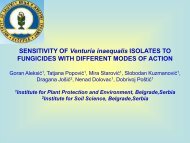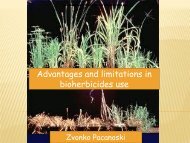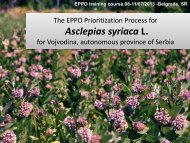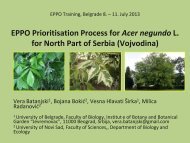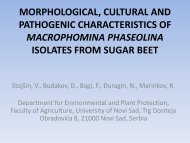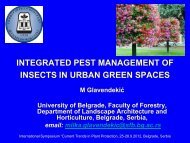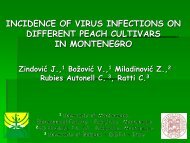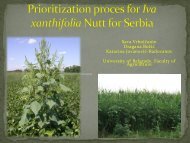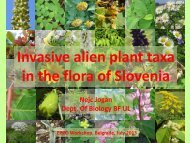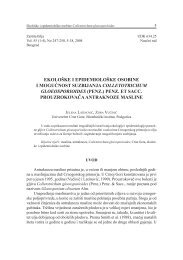ZAŠTITA BILJA PLANT PROTECTION
1 - Izbis
1 - Izbis
- No tags were found...
Create successful ePaper yourself
Turn your PDF publications into a flip-book with our unique Google optimized e-Paper software.
38<br />
Du{ica Deli} et al.<br />
DISCUSSION<br />
There has been a growing interest in using<br />
bacterial inoculants (biofertilizers) in agricultural<br />
production including legumes and cereals (Figueredo<br />
et al., 2008; do Vale Barreto Figueredo et al.,<br />
2011). Significant increases in growth and yield of<br />
agronomical important crops in response to inoculation<br />
with PGPR have been extensively reported<br />
(Kloepper et al. 1978; Zhang et al. 1996; Gupta et<br />
al. 2002; Vessey 2003; Gray and Smith 2005; Figueiredo<br />
et al. 2008). In addition, there is interest in<br />
inoculation of preceding crops with PGPR with<br />
intention to establish PGPR population in soil and<br />
rhizosphere of the next crop (Domit et al., 1990;<br />
Goos et al., 2001).<br />
In our study possibility of alfalfa growth promotion<br />
by inoculation of preceding barley with<br />
PGPR was determined in order to evaluate the plant<br />
growth promoting potential of some strains as inoculums<br />
as well as their influence on subsequent<br />
crop. Presented results indicated that among 5<br />
strains with significant plant growth promoting activity<br />
(A1, A2, P1, P2 and E1), strains of Azotobacter<br />
sp. and one strain (P1) of Pseudomonas sp. own the<br />
greatest plant growth promoting potential.<br />
The both applied strains of Azotobacter sp.<br />
significantly increased alfalfa SDW (about 40%<br />
over control) probably due to its N fixing or the<br />
other plant growth promoting abilities which is in<br />
agreement with results of some authors (Kennedy<br />
et al. 2004; Milošević et al., 2012). It was reported<br />
that particular species of Azotobacter (A. paspali)<br />
with some cereal can fixed 15-90 kg N ha -1 , which<br />
indicates Azotobacter genera as a good diastrophic<br />
useful for both cereals and legumes (Franche et al.,<br />
2009).<br />
Presented results showed different plant<br />
growth promotion abilities of Pseudomonas sp.<br />
strains P1 and P2 indicating that the growth-promoting<br />
ability of some bacteria may be highly specific<br />
to certain plant species, cultivar and genotype<br />
(Lucy et al. 2004). Direct plant grow promoting effect<br />
of boiocontrol agent such as Pseudomonas sp.<br />
in pathogen-free environment is often associated<br />
with following mechanism solubilization insoluble<br />
P source and regulation of plant growth regulators<br />
(Avis et al., 2008). In our results, middle PGPR effectiveness<br />
of Pseudomonas sp. P2 and Enterobacter<br />
sp. strain E1 should not be neglected because<br />
these strains significantly increased SDW over Ø by<br />
22% and 29 %, respectively. Particular Pseudomonas<br />
species could increase yield of some plant species by<br />
25% as well as 60% (Adjanohoun, 2011). Enterobacter<br />
and Pseudomonas genera have been identified<br />
as diazotrophic rhizobacteria with nitrogen-fixing<br />
and PGPR ability in rhizosphera of various plants<br />
that increase the height and plant yield (Minorsky,<br />
2008; Franche et al., 2009; Zabihi et al., 2010).<br />
Species of Bacillus are the most extensively<br />
studied (Minorsky, 2008; Hayat et al., 2010). Diversified<br />
populations of aerobic endospore forming bacteria<br />
of Bacillus species occur in agricultural fields<br />
and contribute to crop productivity. It is very likely<br />
that plant growth promotion by rhizosphere bacilli<br />
may be a result of combined action of two or more<br />
of these mechanisms (Richardson et al. 2009; Kumar<br />
et al., 2011). These bacteria competitively colonize<br />
the roots of plant and can act as biofertilizers<br />
and/or antagonists (biopesticides) or simultaneously<br />
both. However, in presented study B. megaterium<br />
SNji and S. meliloti strain L3Si did not show promoting<br />
abilities. The results of some authors concerning<br />
Bacillus species also pointed to its negative<br />
effect on maize (Adjanohoun, 2011).<br />
Rhizobia are a vast group of soilborne rhizobacteria<br />
with representatives that have proven plant<br />
growth promoting activities through N fixation.<br />
Rhizobal strains are well known N fixers which in<br />
symbiosis with legumes form N fixing nodules but<br />
they can associate with roots of non-legumes without<br />
forming true nodules resulting in the growth<br />
promotion of legumes and non-legumes by different<br />
mechanisms (Avis et al., 2008; Mehboob et al.,<br />
2009). These bacteria can equally produce plant<br />
growth regulations-phytohormones and solubilize<br />
organic and inorganic phosphates that would have<br />
a role in their plant grow promoting activities. Also<br />
presence of rhizobial strains indirectly stimulate the<br />
plant to active its defence mechanisms when challenged<br />
with pathogen through the production plant<br />
defence compounds (Avis et al., 2008). Rhizobia<br />
have a diverse range of activity. In contrast, some<br />
studies have revealed that rhizobial inoculation<br />
may also have deleterious effect on growth and<br />
yield of non- legumes and legumes and only specific<br />
rhizobial strains had potential to be used as<br />
PGPR (Antoun and Prevost, 2000). In this study S.<br />
meliloti strain L3Si applied as inoculant of preceding<br />
barley was ineffective in spite of its high effectiveness<br />
in BNF with alfalfa in our previous experiments<br />
(Delić et al., 2012). Significantly lower values<br />
of alfalfa parameters in comparison the control-Ø<br />
indicated bad relationship between the symbionts.<br />
Reasons for these results can be founded in natural<br />
variations in environment, cultivar, soil and indigenous<br />
microflora of a specific area (Mehboob et al.,



